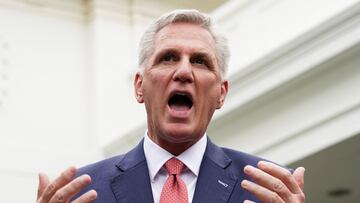What is the debt ceiling? Why can’t the Republicans and Democrats reach an agreement?
Social spending cuts could be seen as the White House and Republican leaders work out a deal over the debt ceiling.

As negotiations over the debt limit continue, bad faith arguments, old tendencies, and a desire to rack up “political wins” have left the United States with two options: cuts to social spending that millions of working-class people depend on or a global financial crisis.
The debt ceiling is a limit placed on the federal government, over which borrowing to finance government operations becomes impossible. Treasury Secretary Janet Yellen sent a letter to Congress informing leaders that if an increase or suspension is not agreed to, the debt limit could be reached by 1 June, giving leaders just under two weeks to make a deal.
The national debt has ballooned in recent years, including under Presidnet Donald Trump. Nevertheless, Democrats and Republicans worked to increase the debt limit without much political fuss surrounding the issue. The current negotiations remind many of those that took place in 2011, when stalling on the part of Republicans to reach an agreement with the White House led to a downgrading in the US credit rating by Standard & Poor’s.
Republican leaders strike an optimistic tone after meetings at the White House
In November, Republicans only managed to secure a slim majority in the House of Representatives, and they are using their control to extract concessions from the White House. With Democrats in control of the Senate, President Biden has made it clear that he will not entertain cuts to Medicare or Social Security; however, his position on cuts to other social programs has yet to be made clear.
With just under two weeks to come to an agreement, the White House has softened its position on social spending cuts and work requirements to receive social assistance. However, President Biden has said he is waiting on the proposal from Republicans before he makes any deal. Speaker Kevin McCarthy said on Tuesday that he believes a deal could be reached by the end of the week.
The debate over work requirements
Whatever proposal is sent to the White House is likely to mirror the “Limit, Save, Grow Act of 2023″ passed by the GOP-led House in late April. The legislation includes various measures to cut federal spending and reduce the deficit. These reductions are not a result of increasing corporate tax rates or reducing the number of tax loopholes. Instead, the legislation eliminates many tax credits and financial incentives for the public and the private sector to invest in renewable energies and nullifies the president’s executive orders canceling billions in student debt.
Work requirements remain a major sticking point
Another major component that Republicans have been more eager to speak publically about is the addition of work requirements for the Supplemental Nutritional Assistance Program, more commonly referred to as SNAP. What the GOP leaders touting these requirements neglect to mention is that they would only impact around fourteen percent of SNAP beneficiaries because the law provides exceptions for people with disabilities, students, parents and guardians, other caregivers, and a few other profiles.
Would Democrats be willing to implement work requirements?
Work requirements have been implemented across a broad range of social assistance programs in the United States since the 1990s. Earlier this week, President Biden, when speaking to reporters, reminded them that he voted for these provisions when he was in the Senate. Over the last two decades, what has become increasingly clear is that corporations, knowing government support is available to its lowest wage workers, will offer pay at levels that continue the dependent on social assistance. The fact that such a small portion of SNAP beneficiaries would be impacted by the change may entice Democrats to support the measure. As stated publically by President Biden and as evidenced by the legislative record of bipartisan support for work requirements, Democrats may be willing to support such a measure to avoid a debt default.
Millions of low-wage workers remain reliant on government assistance
The suggestion that these work requirements will encourage labor force participation is not supported by research. In 2020, the Government Accountability Office reported that there are millions of workers receiving SNAP benefits because the wages they are offered are too low to survive on. Corporations like Walmart and McDonald’s were identified as the businesses with the highest percentage of workers receiving government assistance. Brookings reported in 2019 on the pervasive nature of low-wage and called attention to the fact that in many areas, higher-paying jobs for workers with less education and training were not available. Enhancing labor protections to ensure workers are offered a living wage so that they are able to cut ties with programs like SNAP and Medicaid is essential if, as the researchers at Brookings point out, employers are unwilling to offer higher wages.
If the only jobs available to vulnerable workers are those that continue to keep them dependent on government assistance, perhaps it is not the structure of the assistance programs that should be the center of the debate.






